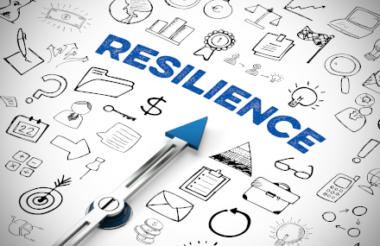In her speech at the Charity Commission’s recent annual public meeting, chief executive Helen Stephenson used the word resilience twice. She praised the resilience of the sector, particularly in the context of the pandemic, which has naturally and understandably become the default context for everything. She also talked about the great strengths of charities which will be required in the immediate and longer-term future – not only in terms of post-pandemic recovery but when faced with issues such as climate change, post-Brexit changes, and macroeconomic uncertainty. It will be crucial to identify the hallmarks of a resilient charity when meeting these challenges.
Resilience is a broad term and can mean different things to different people. Beth Clarke is programme manager of CAF’s Resilience Programme Pilot, which for the last four years has supported 10 small charities to become more resilient. For her, resilience is having time and space to step away from the day-today in order to look at the things that aren’t working and that hold you back. “It is also about the things that may be working fine, but could be so much better if you had the opportunity to reflect and consider different ways of working.”
BRIC (Building Resilience in Communities) is a Lincolnshire-based charity providing support for children and their families. Tracey Good, CEO, says that resilience is not just about having a positive cash flow. “It’s about having the people and the partners around us who have the skills and the attitude to be able to deal with the now, to be able to provide what we want to deliver for our beneficiaries, while also responding to changes that are coming. It’s about being able to look into the future, and to ensure that we’re able to always make decisions based on the children and families that we support.”
Sarah Atkinson took on the role as CEO of the Social Mobility Foundation (SMF) in January 2020. The charity works with young people from disadvantaged socioeconomic backgrounds to help them access opportunities in education and the workplace. “As a staff team, we talked the other day about resilience and what it meant. In the context of a volatile, uncertain, complex, ambiguous world, we came up with this structure where resilience is about vision, understanding, clarity and agility.”
Harriet Stranks is director of grants at Lloyds Bank Foundation (LBF), who started providing organisational resilience support for over 1,000 of the charities that it funds in 2014. “For me, organisational resilience comes from personal resilience, building trusted relationships and networks and making sure that you’re thinking about the wellbeing of yourselves and your staff teams. This can then lead to the confidence and the strength to be able to work through tough times.”
Gatwick Detainees Welfare Group is a charity based in Crawley that supports immigrants at two detention centres. Anna Pincus, director, says that Stranks’ remarks really resonate with her, because “we are all about creating a person-centred charity”.
“We want to treat our staff with the same compassion that we treat our service users – which we don’t always see in the charitable sector – and build a strength of community. To me resilience is about ensuring that we’re flexible and adaptable to meet whatever changes come our way.”
Shane Ward is CEO of the West Bromwich African Caribbean Resource Centre (WBACRC). “Our primary purpose is serving the Black African Caribbean diaspora community. Part of resiliency in that context is about defining yourself. Over the last few years there’s been this term BAME, which is an invented term not owned by the Black community but imposed on it. Part of our resilience has been actually to say this, and more narrowly identify who our target beneficiaries are. It is also about sharing information, building skills and creating networks.”
Good remembers that when the pandemic hit, BRIC had just been through a restructure and rebrand following issues identified on the CAF Resilience programme, so in some ways it felt like a very new organisation although it had been around for a long time. “Lincolnshire is hugely rural so we had already been through a process of establishing a completely remote staff structure. One of the things that really helped us was that the IT infrastructure was in place, so could respond very quickly to the crisis and helped us to turn our support for the families and children, from what previously would have been home visiting or sessional-based activities, to being online.”
Funding
Atkinson praises the enormous support of its funders. “They also didn’t know what they were going to be able to do but wanted to stand by their commitment. They didn’t say ‘tell us what you’re going to do and we’ll decide if we will fund it’, but ‘do your best and let us know what you’ve done’. That made a massive difference because it meant we put our energy into trying to work out what our best was, rather than trying to scope a plan that we could report on and agree with funders up front. I am certain that made us much more innovative and push harder than we would have if we’d needed to commit to things that we would have had to plan.”
From a funder’s perspective, Stranks identifies that what was really useful was the ability to be really flexible and to accelerate the pace of change.
“Some of the things that we did really supported charities. We unrestricted all of our grants, and said don’t focus on monitoring and outcomes. Our focus was to help charities get through the next 12 months and to give them the freedom and flexibility to do whatever they needed to do in whatever way they needed to do it. It was a complete removal of funder power and that step would have taken us a very long time, under normal circumstances. Because of the pandemic we moved at pace and have kept an awful lot of that practice now.”
Clarke suggests that a lot of funders very much dislike the idea of overheads. “What they want to do is change the world with their money and some feel that by funding overheads they’re not really doing that. It is too many steps removed, which I would disagree with. But do they want to fund a charity with excellent safeguarding and brilliant processes and transparent finances? If the answer is yes, then fund the overheads, as well as the work itself, because overheads enable those things to happen.”
Atkinson points out that corporate partners often want to fund things that are proven. “You often get asked how you are going to be the best at doing something. The experience that we’ve been through over the last couple of years has encouraged us to talk about our record and why we know what we’re talking about. This helps us argue that the learning and development we want to do is going to be good, even if we’re doing something that’s not proven yet.”
Strengths and weaknesses
Pincus says that at the risk of stating the obvious, resilience is a question of making sure that you’re asking the right questions when you’re looking at strengths. “Those questions should come from your service users and help embed their lived experience at every level of the organisation to make sure that the way they see the world is being reflected in decision-making.”
Good talks about being very clear about strategy and having a very simple process that says “this is what we aim to do, this is what we’ve done, this is the impact, and this is what we intend to do again or for the first time going forward”.
One of the things WBACRC did as part of the CAF Resilience programme was go through a very comprehensive SWOT analysis, as well as utilise their theory of change and a futurology study into the emerging needs of their community.
“We identified areas that we wanted to develop, but we needed some support. For example, we didn’t have a comprehensive fundraising strategy,” Ward says. “We didn’t know how we compared with similar types of organisations across the country, so CAF did some benchmarking exercises. It was quite eye-opening because when you are in the thick of the day-to-day you don’t realise how well you are doing or how badly. Being able to recognise that in comparison with other organisations you are not doing so badly actually boosts your confidence.”
Atkinson considers the advantage she had in being new to her organisation. “Where the team were really focused on the delivery, I was able to reflect more from the outside. You can reassure them that they are doing a good job: ‘It’s hard because it’s hard, but you’re doing it well. You’re doing what you’re supposed to be doing.’ Sharing the reflections, the good news, the encouragement, the strengths and weaknesses from external reflections is really important, because it is very easy to get lost in your own work, especially when things are difficult. It’s very difficult to see outside of what you’re doing.”
Hybrid working
Atkinson is one of many CEOs grappling with trying to plan hybrid working for staff and hybrid delivery of programmes. “Some of the things that we offer students we’re going to keep online because engagement, reach and consistency across the UK has been better. Some things will be face-to-face, because we know that the quality of outcomes around networking and confidence building have dropped. The tricky thing is trying to align the right kind of hybrid for delivery and outcome for beneficiaries, and for staff wellbeing. The conclusion we’ve come to is that there will be efficiencies to gain from this but that’s going to take a while. It’s going to cost us more and be harder to do things hybrid before it starts to become easier and more efficient and we’ve just decided we’re going to have to suck that up.”
Ward says that WBACRC staff are now back in the offices and are re-establishing services as they were previously. However, there have been changes to working patterns. “Some people like to start work a bit earlier so they’re coming in at 8am instead of 9am and leaving earlier. And we have found that people are working later voluntarily, and are looking at emails at 7pm or 8pm, where they probably wouldn’t have done that before.”
Clarke raises the difficulty of spotting when a colleague is overwhelmed. “It’s very easy to see in an office. You can see someone’s body language. It’s very easy to say: ‘Oh, are you alright?’ When people work at home, you don’t spot things in the same way, and they have to actually have the confidence to speak up.”
Impact
Good says BRIC has reviewed its work on impact measurement. “One of the biggest things that we are doing is trying to understand what our objectives are, and who we are as an organisation. We reached a point where we were gathering so much information about so many things, but was it meaningful? You need a clear strategy about where you’re going to, and then be able to measure it and know why and what you’re measuring."
Clarke says that it’s rare to find a charity that isn’t doing some sort of impact measurement, but finds that all too often it is focused on reporting to their funders. “It gives them comfort that their money has been used as it should be, but it should also be for you as an organisation to know what you are, and what you are achieving.”
Looking ahead
Good predicts that the economic picture is going to remain pretty bleak. “The challenge is going to be not falling into the trap of chasing the funding but sticking to our beliefs and our objectives. We need to be brave about what we do and don’t apply for to ensure that we’re continually supporting and serving children and families. Collaborations and coalitions with other organisations and other sectors is going to get us through.”
Pincus thinks that considering the impact of climate change on immigrant and refugee communities in the UK is crucial. “But wider than that, we have to do something to create a political space that isn’t polarised as that is what tends to happen to political debate at times of crisis. We are trying to develop empathy and tell stories of what’s real to counter that. We have to be visionary to inspire the people that we are supporting to give them hope. But because the future’s looking so bleak, the challenge is to keep your community inspired but also be entirely realistic by giving them short-term goals to work towards.”
SMF has been reflecting on how to move from crisis response to strategic intent. Atkinson states: “There is something quite polarising about the combination of significantly heightened public awareness of inequality and appetite for a fair society at the same time that economic and social divisions are getting bigger. We need to show leadership and engage in that conversation about the way forward on fairness and equality against the backdrop of the culture wars debate.”
Ward wants to follow through some of the findings of a Covid report WBACRC undertook. “It is primary data rather than hearsay, actual research that’s been conducted so we would look to follow through a lot of that where people are talking about, for example, not feeling valued as a care worker. A lot of the issues that came about are about inequality, so we are going to be taking some of those recommendations directly to clinical commissioning groups locally, and engaging with them.”
Stranks feels a need to shift from a very competitive society to a more collaborative one, where power is moved to people in communities rather than being held by those with all of the money. “Thinking a bit more macro and globally is the step-change that we all need to make.”
Clarke concludes: “Working together is what makes a difference, whatever the next crisis might be, or whatever the circumstances are going forward. There will always be people that need help, there will always be great organisations that want to do that, and there will always be funders that want to put money into the best ways of achieving it. A lot of the things that we’ve talked about are the ingredients for enabling that.”
With thanks to CAF for its support with this feature
Related articles











